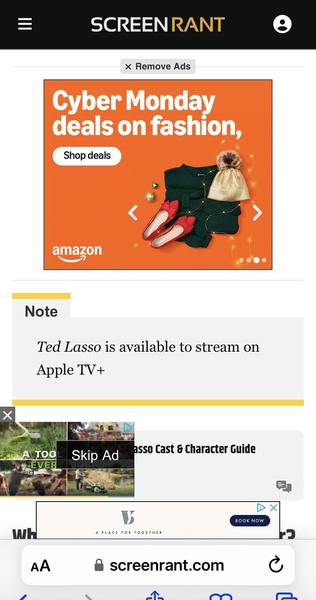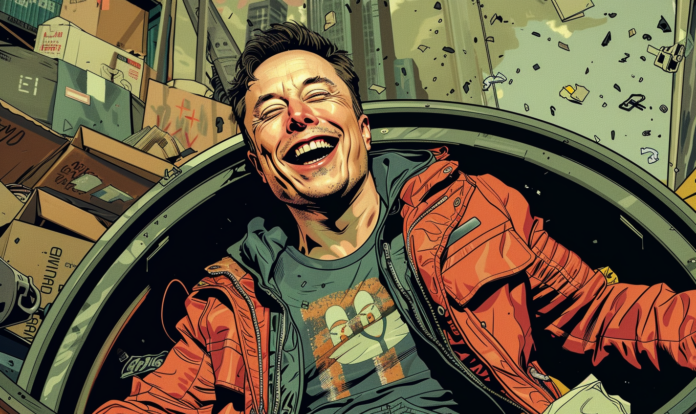Mobile web advertising is the embarrassing uncle at Thanksgiving—awkward, outdated, and somehow still getting attention despite adding no value to the conversation.
It’s a relic of the early internet, clinging to life in the most chaotic, maddening way possible.
Marketers, it’s time to stop the charade. The numbers are in, the experience is trash, and this digital zombie needs to be put to rest.
A Nightmare in Pixels
If you’ve had the misfortune of navigating a mobile website recently, you know the pain—it’s a gauntlet of irritation that somehow feels both outdated and aggressively modern in all the wrong ways. Picture this: you’re innocently trying to read a pop-culture article on Screen Rant.
Maybe you just want to know why the latest Marvel movie tanked or catch up on rumors about the next season of Ted Lasso. Simple, right? Wrong.
The moment the page loads (or half-loads, because let’s not pretend these sites have optimized anything), you’re greeted by banner ads so ugly they seem ripped straight from the Geocities era—blocky text, bad colors, and maybe even a pixelated GIF for good measure. If these banners had a scent, it would be desperation mixed with stale coffee.
Then, without warning, an autoplay video crashes the party. It blasts irrelevant content at full volume while hijacking your entire screen. What’s it about? Who knows. It’s not like you asked for an ad about luxury car leases when you’re here for Netflix gossip. It’s like a bad houseguest who eats your leftovers, commandeers your TV, and never leaves.
But wait, there’s more! Just as you recover from the video ambush, the pop-ups arrive. Oh, the pop-ups. Relentless, soul-crushing little boxes that demand you subscribe, download, or take advantage of a deal nobody actually wants.
They don’t just appear—they linger, daring you to “find the X” like some twisted escape room challenge.
And let’s be honest: that “X” is always so tiny and sneaky, you wonder if it’s part of some malicious psychological experiment.
And the cherry on this digital disaster sundae? None of these ads actually work. They don’t inform, persuade, or engage. They just hover there—awkward, intrusive, and utterly unclickable—like the digital equivalent of a mosquito buzzing around your bedroom at 2 a.m.
You’re swiping, scrolling, and rage-tapping, but nothing gets rid of them. They’re not selling products; they’re selling frustration.
Can someone explain the video ad below where the “skip ad” is the most visible part, along with no call-to-action, barely visible, no one wanted to pay for this. Anyone?

As one exasperated user put it:
“Nobody wants to sit there through commercial after commercial, advertisement after advertisement. After just a couple, I’m flipping the page and searching elsewhere. It’s obvious to me, but I guess common sense for some eludes others.”
And there it is: the truth we all feel but rarely articulate. These ads aren’t just a nuisance—they’re actively driving people away. Instead of drawing users in, they’re sending them scrambling for the back button like it’s a life raft.
In a world where attention is the most precious currency, mobile web ads are burning through goodwill faster than a dumpster fire in a windstorm.
The Numbers Don’t Lie—But Ad Tech Might
Let’s talk about the numbers, and oh boy, do they paint a grim picture for the mobile web. Mobile users, on average, spend a laughably meager 19 minutes per day navigating the wild west of mobile websites. Nineteen minutes. That’s about the same amount of time it takes to decide what you’re not going to watch on Netflix tonight. And yet, brands are somehow convinced this sliver of attention span is worth billions of dollars in advertising spend.
Now, let’s stack that against the nearly four hours a day users devote to apps. Four hours! That’s where the magic happens. Apps are where we scroll through endless TikTok dances, slide into DMs, and binge on true crime podcasts. It’s where people actually engage, consume, and even (gasp!) convert. So why, oh why, are advertisers pouring cash into a channel that gets less love than a floppy disk in 2024?
The answer is simple, if depressing: denial. Denial, it seems, has become a key performance indicator for the ad tech industry. No matter how clear the data is, marketers are out here throwing their budgets into the mobile web void like it’s some kind of Hail Mary pass. They’re holding on to the fantasy that the web is still a major player, despite the reality that users are only grazing its surface like bored teenagers at a buffet with nothing but salad left.
And the spend? It’s obscene. Billions are being funneled into mobile web ads that no one sees, no one clicks, and no one cares about. These ads are so ineffective that they might as well come with a disclaimer: Warning: ROI not included. Yet, the industry keeps the grift alive, propping up a dying format like a stage parent trying to turn their kid’s one-liner in the school play into an Oscar-worthy performance.
The question we should be asking is not just “Why is this happening?” but “Who benefits from this delusion?” Spoiler: it’s not the brands. Agencies and DSPs are raking it in, happily taking their slice of the pie while the rest of us watch this digital dumpster fire burn. Publishers, meanwhile, are slapping ads on anything that moves, hoping to squeeze a few pennies out of their ad slots before users install yet another ad blocker.
But here’s the kicker: users don’t care. They’ve already voted with their time and attention, and apps are winning by a landslide. If the mobile web is a sad, deserted amusement park, apps are the shiny new theme park where everyone wants to hang out. And no amount of banner ads, autoplay videos, or pop-ups is going to change that.
So let’s stop pretending this is working. Mobile web advertising isn’t just inefficient; it’s a monument to the industry’s inability to let go of outdated strategies. The data doesn’t lie, but apparently, the industry’s collective ego is louder than any statistic. It’s time to call it: the mobile web is the ad channel equivalent of Blockbuster in the age of Netflix. Pack it up, folks. This show is over.
Even those inside the industry know it’s a scam. One mobile tech insider told us:
“Have you ever asked why so much ad tech money is spent on mobile web when the data shows it’s useless? I don’t have access to what agencies and brands spend, but look at the public site lists from DSPs—it’s all websites. It’s the great robbery of ad dollars.”
But he added a caveat:
“Obviously, this is all off the record. I wouldn’t want to upset my DSP or agency clients.”
Translation: Everyone knows it’s broken, but no one wants to bite the hand that feeds them.
The Click-Through Conspiracy
Here’s the kicker: nobody clicks these ads—at least not intentionally. Sure, there are “clicks,” but let’s be real about where they’re coming from: fat fingers. Yes, the accidental tap rate—known as the “fat finger” rate—is sitting pretty in the upper 60% range, which means more than two-thirds of those clicks are nothing more than digital slip-ups. Think about it: most mobile web ad engagement is literally a mistake. Advertisers aren’t buying clicks; they’re buying oopsies.
This isn’t a new problem, but somehow, the industry has decided to ignore it, treating accidental clicks like a win instead of the sad metric they are. Imagine if restaurants measured success based on the number of people who walked into their door by accident. “Oh, you thought this was the restroom? That counts as a diner now!”
And let’s not forget that even when someone does tap on an ad, the experience is often so painful that any glimmer of potential conversion evaporates immediately. One wrong tap leads to a new tab full of loading screens, broken links, or—worse yet—another maze of ads. It’s not just inefficient; it’s outright insulting to the user.
But the fat finger phenomenon is only half the story. The other half is the blatant user hostility of these ads. Remember that poor soul who tried to look up NFL playoff scenarios? Here’s how they described it:
“I searched for ‘NFL playoff scenarios’ and landed on a site where the actual content was buried under autoplay videos, pinned ads, and pop-overs. The viewable area for the article was maybe 200 pixels. It was unusable.”
Unusable, indeed. Not only is the content smothered by ads, but the very design seems to bait accidental clicks. You’re trying to scroll, but your thumb grazes an ad just enough to trigger it. Suddenly, you’re whisked away to some landing page you didn’t want, didn’t ask for, and will never return to.
This isn’t advertising—it’s entrapment. And the saddest part? Nobody wins. The user is frustrated, the brand’s reputation takes a hit, and the advertiser just paid for another meaningless fat-finger click. It’s a lose-lose-lose scenario masquerading as a marketing channel.
So here’s the reality check: the mobile web is no longer a viable space for ads. If your business strategy relies on fat fingers to succeed, it’s not a strategy—it’s a comedy of errors. And no amount of denial is going to change that. Time to move on.
Why Is This Still Happening?
Because the ad tech ecosystem is addicted to the status quo. DSPs, agencies, and publishers are clinging to mobile display ads like a washed-up celebrity refusing to leave the stage. Why? Money. Lots of it. They’re making too much cash from this carnival of inefficiency to face the harsh truth: mobile web display advertising is virtually useless outside of apps. Instead of fixing the problem, they slap on a few Band-Aids, call it “optimization,” and keep raking in profits. It’s like rearranging deck chairs on the Titanic and calling it interior design.
But here’s the brutal reality: if you’re still buying display ads, you’re probably wasting your money. And if you’re buying mobile display ads on the web, you’re not just wasting it—you’re handing it over to fraudsters on a silver platter. Let’s not mince words: mobile display is almost 100% fraud at this point. Bots, fake impressions, and accidental clicks (hello, fat fingers!) dominate this space, turning your hard-earned marketing dollars into pure vapor.
The solution? It’s been staring us in the face for years: stop buying mobile web display ads. Redirect that money to places where users are actually engaging—apps, Connected TV (CTV), and platforms that deliver value instead of frustration.
And if you absolutely must buy display, here’s a golden rule: block mobile display inventory. Seriously, block it. Treat it like the digital plague it is, because leaving it in your media plan is like leaving your wallet on a park bench and hoping it’s still there tomorrow.
Time to Call It
It’s time to stop pretending. Mobile web advertising isn’t just dead—it’s decomposing in plain sight. What we’re witnessing now is a desperate, zombie-like march of an industry too stubborn, too bloated, and too greedy to evolve. The users have moved on, the numbers are a public humiliation, and even the insiders admit this whole charade is built on smoke and mirrors.
So here’s the challenge for brands: be better. Stop feeding the beast. Stop funding this nonsense. Invest in channels that respect your audience’s time and attention. Apps? Yes. CTV? Absolutely. Hell, even skywriting would probably deliver better ROI than mobile web display at this point.
Or, if you’re feeling particularly generous, keep throwing your budget into the void and wondering why your ROI is six feet under. Keep lining the pockets of ad tech middlemen while users install ad blockers faster than you can say “banner blindness.” Just don’t say you weren’t warned when your next campaign results are a hot mess of wasted impressions and nonexistent engagement.
Because, honestly, this zombie isn’t walking anymore. It’s decomposing in real time, leaving a trail of bot traffic, fat-finger clicks, and broken user trust.
Let’s bury it, for good this time, and move on to strategies that actually make sense in a world where attention is the ultimate currency.





















